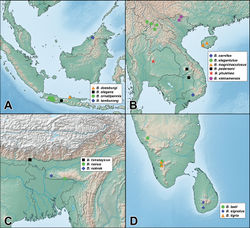Bolitogyrus lasti
| Notice: | This page is derived from the original publication listed below, whose author(s) should always be credited. Further contributors may edit and improve the content of this page and, consequently, need to be credited as well (see page history). Any assessment of factual correctness requires a careful review of the original article as well as of subsequent contributions.
If you are uncertain whether your planned contribution is correct or not, we suggest that you use the associated discussion page instead of editing the page directly. This page should be cited as follows (rationale):
Citation formats to copy and paste
BibTeX: @article{Brunke2017ZooKeys, RIS/ Endnote: TY - JOUR Wikipedia/ Citizendium: <ref name="Brunke2017ZooKeys">{{Citation See also the citation download page at the journal. |
Ordo: Coleoptera
Familia: Staphylinidae
Genus: Bolitogyrus
Name
Bolitogyrus lasti Rougemont, 2001 – Wikispecies link – Pensoft Profile
- Bolitogyrus lasti Rougemont, 2001: 111.
Type locality
Cinchona [=Cinchona Rd. between Makkanduru and Hwy 88?], Karnataka, India.
Type material
Bolitogyrus lasti Rougemont, 2001.
Holotype (♂, MMUE): Manchester Museum, HOLOTYPE [pink printed label] / F3008.11058 [printed] / HOLOTYPE Bolitogyrus lasti det. G. de Rougemont [red printed label] / AJB0000410 [identifier label].
Paratype (♀, MMUE): Manchester Museum, PARATYPE [printed label] / F3008.11058 [printed] / PARATYPE Bolitogyrus lasti det. G. de Rougemont [yellow printed label] / AJB0000521 [identifier label].
Other material
INDIA: Kerala: 10 km WSW Munnar, Kallar Valley, 10.05 76.97, 1100–1200 m, 7–8.I.1999, D. Boukal, 1 ♂ 1♀, AJB0000411, AJB0000523 (NMW); same except, 15 km SW Munnar, Kallar Valley, 1000 m, 6-18.XII.1993, Boukal and Kejval, 1 ♀, AJB0000524 (NMW).
Tamil Nadu: Kadamparai [hydroelectric dam], V.1963, P.S. Nathan, 1 ♀, AJB0000522 (CNC).
Diagnosis
This species can be distinguished by the following character states: head entirely dark; elytral disc dark with pale markings not extending onto epipleuron (Fig. 5F); pronotal margin narrow, almost without expansion (Fig. 4G).
Redescription
Measurements ♂ (n = 3): HW/HL 1.34–1.42; PW/PL 1.26–1.29; EW/ EL 1.15–1.16; ESut/PL 0.83–0.85; PW/HW 0.98–1.0; forebody length 5.1–5.4 mm.
Measurements ♀ (n = 3): HW/HL 1.34–1.38; PW/PL 1.11–1.15; EW/ EL 1.12–1.17; ESut/PL 0.75–0.80; PW/HW 0.95–1.03; forebody length 5.3–5.8 mm.
Coloration: head, pronotum and abdomen entirely dark; elytra with pale yellow, raised markings, inner marking oval shaped and larger than outer circular marking; antennomeres 1-3 dark brown, 4-5 reddish, 6-10 dark brown, 11 distinctly paler, light brown to yellowish; palpi dark brown, apical segment paler; legs yellow, forecoxae dark brown, femur with dark band in apical half, tibia entirely dark with ventral face sometimes paler.
Head distinctly transverse; dorsal surface with moderately dense, clearly separated asetose punctures, frons with only scattered punctures and poorly impressed. Antennomere 6 slightly, 7-10 distinctly transverse and more or less symmetrical.
Pronotum distinctly (males) to slightly transverse, about as wide as head, with shallow micropunctures scattered on disc, becoming more distinct on anterior angles. Elytra slightly transverse, suture slightly to distinctly shorter than pronotum at middle.
Abdomen with disc of tergites III-VI distinctly and broadly impunctate; sternites III-IV with basal line distinctly projected posteriad at middle.
Median lobe in lateral view with apical portion projected ventrad, apex deflexed dorsad (Fig. 12I); median lobe in parameral view with basal teeth appearing at lateral margins (Fig. 12H); paramere shorter than median lobe, bilobed, lobes narrowly separated and slightly convergent (Fig. 12J); peg setae occurring in long group on each lobe from apex to just apicad of emargination (Fig. 12J); male sternite VIII with extremely shallow emargination and triangular glabrous area medially; male sternite IX moderately expanded at midlength, with distinct U-shaped emargination.
Female with tergite VIII entire (female paratype) to emarginate, emargination minute to small; tergite X elongate shield-shaped, with broadly rounded apex, disc slightly raised and without depressions or strong ridges.
Distribution
Figure 20D. Endemic to the Western Ghats of India.
Bionomics
Bolitogyrus lasti has been collected at 1000-1200 m during January, May, September and December.
Comments
Bolitogyrus lasti is most similar externally to B. ornatipennis from Java but can be distinguished by the narrow pronotal expansion and more circular inner pale elytral spot.
Taxon Treatment
- Brunke, A; 2017: A revision of the Oriental species of Bolitogyrus Chevrolat (Coleoptera, Staphylinidae, Staphylininae) ZooKeys, (664): 1-97. doi
Images
|
Other References
- ↑ Cai Y, Zhao Z, Zhou H (2015) Taxonomy of the genus Bolitogyrus Chevrolat (Coleoptera: Staphylinidae: Staphylinini: Quediina) from China with description of seven new species. Zootaxa 3955: 451–486. https://doi.org/10.11646/zootaxa.3955.4.1



![Figure 12. Bolitogyrus magnimaculosus Cai et al. (A–C), B. nokrek Brunke (D–G), B. lasti Rougemont (H–J) and B. tigris Brunke (K–M). Aedeagus in parameral view (H, K), median lobe in parameral view (A, D), median lobe in lateral view (B, E, I, L), peg setae of paramere (C, F, J, M), paramere in lateral view (G). Figures A–C modified from Cai et al. (2015)[1]. Scale bars: 0.5 mm.](https://species-id.net/o/thumb.php?f=Zookeys-664-001-g012.jpg&width=221)
